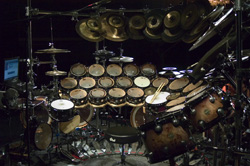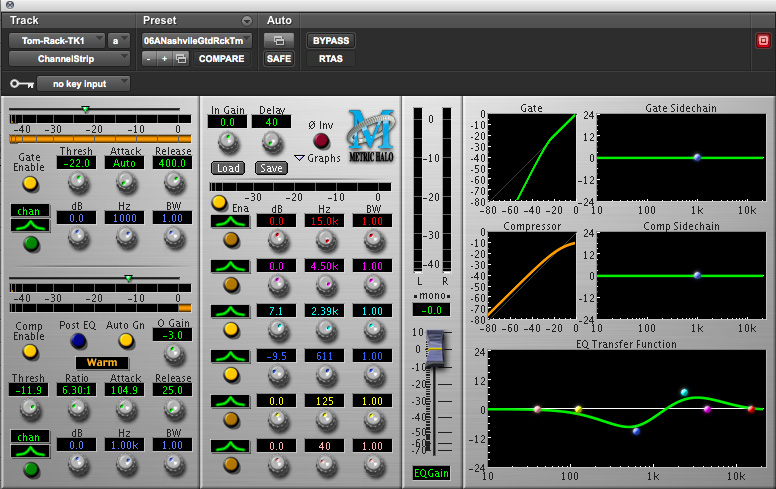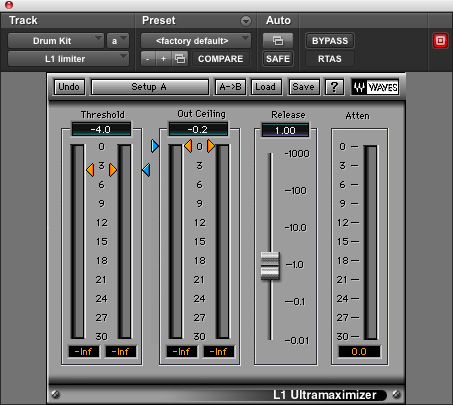
High (Rack) Tom
Like the low tom, the high tom has it’s own frequencies that should be cut/accentuated to bring out the sweetest parts of the sound.
For EQ, I’ll do another big cut of around 10dB at 600hz and I’ll make a similarly big boost of around 7dB at approximately 2k.
For compression, I use a slightly more aggressive 6:1 ratio slower attack (100ms) and a quick release (25ms).
As with the low tom, I’ll gate the high tom using the identical gate attack (fastest “auto”) and release (400ms).
The key to the threshold is to adjust it until only the high tom punches through keeping the channel essentially muted for the rest of the time.
A final note on the toms, as all tom sizes, tunings and even drummers are different, you’ll need to play with these settings until you find the sweet spots.
Overheads / Room Mics
Given that we’ve made a real effort to isolate and enhance each of the individual drums in the kit, overhead mics serve the dual purpose of capturing the cymbals and integrating the blended sound of the kit back into the sound of the drums. I pay attention to three specific EQ points in order to give the overhead mics a clean, balanced tone.
First I’ll use a high pass filter (shelving EQ) at the very low frequency of 40hz to clean up any unnecessary sub-sonic rumbling. Then I’ll pull around 5dB at between 100 and 200hz to prevent any low-mid buildup.
Finally, if necessary, I’ll enhance the overall brightness of the cymbals/kit with a small 1-2dB boost at around 5k. For compression, I’ll set the ratio at about 3:1, the attack at around 110ms and the release at a slightly quicker 70ms.
The threshold should be adjusted to make sure that the overhead/room sound blends with the overall kit mix. Finally, adjust the volume of the overhead mics in the mix until you pick up just enough of the room to put some air and depth back into the kit.
Limiting the Sub Mix
A final trick to add punch to the overall drum kit is to send all of the individual tracks to a stereo sub mix and place a limiter like the Waves L1 on that stereo auxiliary track.
By adjusting the threshold until the attenuation is between 5-7dB, you’ll find that the kit has a really satisfying overall punch and presence.
Conclusion
While I’ve been painfully specific about EQ, compression and gate settings, it’s important to remember that every mix situation is different. Use all of these settings as a jumping off point and then use your ears to tweak the sounds until you’re happy. Good luck!
In the music business for over 20 years, Cliff Goldmacher is an engineer, producer and owner of recording studios in Nashville and New York City. A multi-instrumentalist, Cliff has recorded, played on and produced thousands of demos for major and independent publishers, brand new songwriters and Grammy winners. The demos Cliff has recorded have ended up as major label cuts, in feature films and on television.
For more audio/sound related content and resources, go to Audiofanzine.



